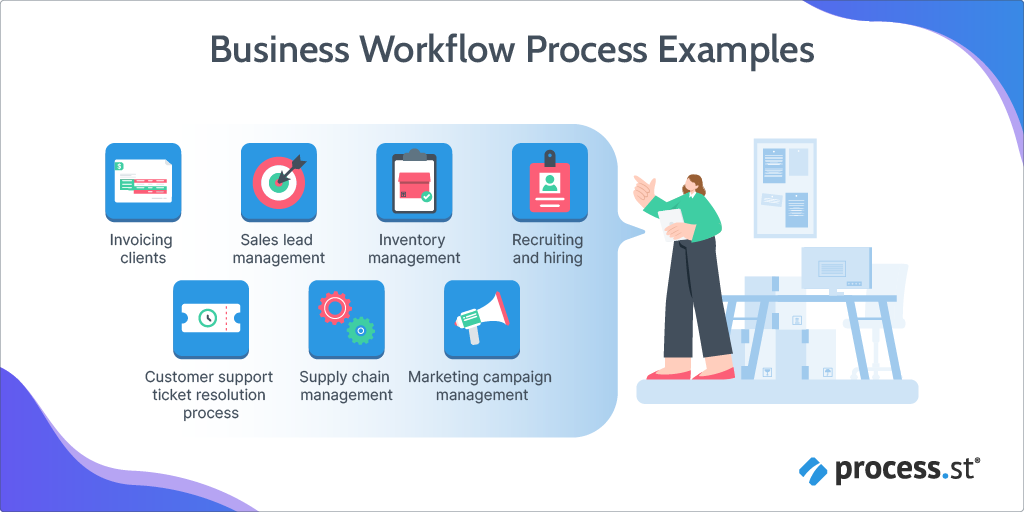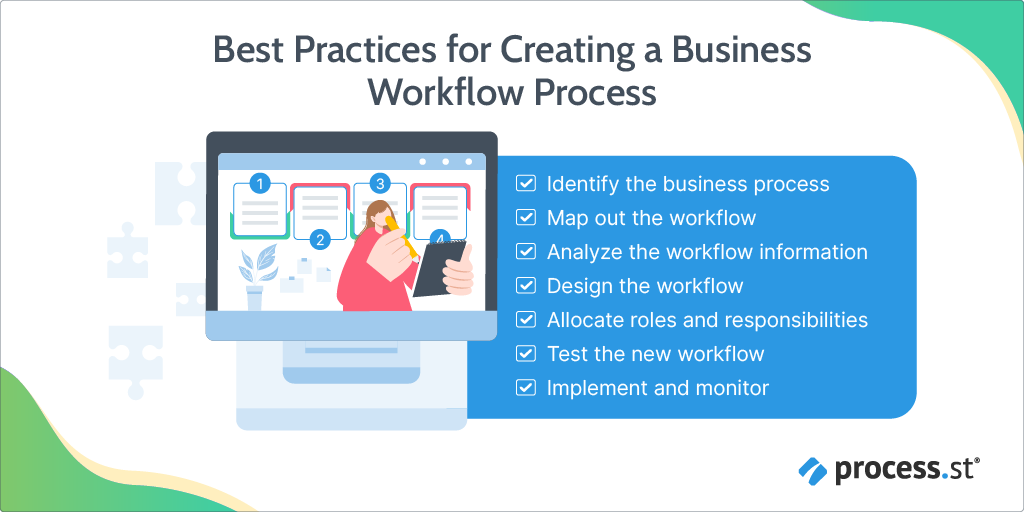Get work done right, and right-on-time with our industry leading BPM platform.
What Is a Business Workflow Process? Benefits, Examples, Best Practices
Whether you’re a small business owner or part of a larger organization, understanding and optimizing your business workflow process can lead to significant improvements in efficiency, productivity, and ultimately, success.
As operations continue to grow and evolve, it’s becoming increasingly important to streamline processes and digital workflows in order to stay competitive. One way to achieve this is by implementing a well-designed and effective business workflow process.
When done right, it can increase productivity, improve communication and collaboration, and ultimately lead to better outcomes for customers and stakeholders. But your organization can quickly break into chaos if business workflow process management is done wrong. It’s make or break. Here’s how to make sure you don’t fall under the latter:
- What is a business workflow process?
- Why is it important to have a business workflow?
- Examples of a business workflow process
- Key components of a business process
- Benefits of good workflow process
- What challenges do you face during the workflow creation process?
- The business workflow process: Best practices
- Maximize your efforts with business workflow process management software
- Features to consider before picking business process software
- Effective workflow management is your key to operational success
What is a business workflow process?
A business workflow process refers to the sequence of tasks and activities that are required to complete a specific business process from beginning to end. This process often involves multiple steps, such as gathering necessary information, obtaining approvals, completing repetitive tasks or assignments, and communicating with key stakeholders.
The primary goal of a business workflow process is to ensure the timely and efficient completion of a business task or process. A well-designed and effective workflow management process can help improve overall productivity, streamline processes, and increase efficiencies.
Some common workflow tools and technologies used to create workflow diagrams include process automation software, business process management systems, and communication and collaboration platforms.
Why is it important to have a business workflow?
A business workflow process is important because it allows businesses to streamline and optimize their operations, improving productivity and efficiency. By breaking down complex processes into smaller, manageable steps, businesses can identify areas for improvement and implement solutions to address them.
This can result in:
- Shorter turnaround times
- Faster response rates
- Increased capacity to handle higher volumes of work
- Improved communication and collaboration between team members and departments
- Increased customer satisfaction
- Better quality control
Ultimately, the success of a documented process depends on the ability to identify and address inefficiencies and bottlenecks in order to continuously improve and refine the process over time.
Examples of a business workflow process
Here are some common types of workflows that you can find in an organization:

Invoicing clients
Your client invoice process involves the creation and distribution of invoices to clients for services or products rendered. This process also includes the management of any resulting payments or receipts.
Sales lead management
A sales lead management workflow template involves the tracking and management of potential customers or leads. This is from initial contact through to purchase, as well as the nurturing of leads that may not be immediately ready to convert.
Inventory management
This project workflow involves the tracking and management of inventory. Such inventory management would include ordering, receiving, storing, and distributing of goods, as well as the management of any associated costs.
Recruiting and hiring process
A hiring workflow process involves the management of the hiring process for new employees. Your hiring workflow would include job postings, resumes screening, interviewing, job offers, and onboarding new hires.
Customer support ticket resolution process
This business workflow process involves the management of customer support requests. Your customer support ticket process consists of the intake of support tickets, the assignment of the ticket to an appropriate representative, and the progress of the request through to resolution.
Supply chain management
Your supply change management process should involve the tracking and management of goods and services as they move through the supply chain. Your ideal supply chain management process runs from production to delivery to the end consumer.
Marketing campaign management
A marketing campaign management process includes the management of marketing campaigns. This is from the creation of the initial campaign plan to the execution of the campaign across various channels. You would also include the measurement and reporting of campaign performance metrics in this business workflow process.
Key components of a business process
Here are some key components that make up an effective business workflow process:
- Clear definition and documentation of the process and steps involved, including input and output data, roles and responsibilities, and decision points.
- Use of automation tools and technology to speed up and optimize the process, such as workflow management software or process management software.
- Regular monitoring and measurement of the process performance, including tracking key performance indicators (KPIs) and making improvements based on data analysis.
- Adequate training and support for employees involved in the process, to ensure they understand their roles and responsibilities and have the necessary skills to execute their tasks effectively.
- Integration with other business processes and systems, to ensure seamless exchange of data and information between different parts of the organization.
- Regular reviews and updates of the process, to ensure it remains relevant and effective in the context of changing business needs and priorities.
Benefits of a good workflow process
Good business process workflows have far-reaching benefits for any organization. Here are some of the most common:
Increased efficiency
By optimizing the steps involved in a process, reducing waste, and minimizing errors, workflow processes can help to streamline operations and improve overall efficiency.
From this efficiency is increased, which translates to improved productivity, cost savings, and increased customer satisfaction.
Added consistency
When clear steps and guidelines are defined, business workflow processes make sure a consistent approach is followed (with reduced errors). This can contribute to better quality control and customer satisfaction, and can also help to establish trust and credibility with stakeholders.
Bettered communication
Workflow mapping can help to improve communication between team members and with external stakeholders when:
- There’s a clear understanding of the roles and responsibilities of each team member involved in a process
- Communication channels are defined
- Protocols for sharing information and data are established
This can contribute to better collaboration and coordination, fewer mistakes, and more efficient use of time and resources.
Easy scalability
Business process workflows help businesses to scale their operations and handle increased volumes of work by:
- Streamlining processes
- Reducing the need for manual input
- Removing bottlenecks
This scalability then helps businesses meet demand during peak periods, reduce lead times, and grow their customer base. All-in-all, a well-designed workflow process can help organizations to achieve their growth objectives and respond more quickly and effectively to new opportunities in the market.
What challenges do you face during the workflow creation process?
Some challenges you might face when creating an entire workflow process include:
Identifying and mapping out the processes
It can be challenging to identify all the processes involved in a particular task or project, especially when working with complex systems.
Defining clear steps
Once the processes have been identified, it can be difficult to define clear steps for each of them, particularly when dealing with interdependent steps or processes.
Ensuring consistency
It can be a challenge to ensure that each team member follows the process in the same way every time, particularly when there are multiple individuals involved.
Addressing change management
Workflow processes must be flexible enough to accommodate changes in the system but also structured enough to ensure that changes do not disrupt the workflow.
Ensuring adoption
Successfully implementing a new business workflow process can be challenging if there is resistance to change or if team members are not properly trained or motivated to adopt the new process.
Maintaining the process
Regular monitoring and evaluation are necessary to ensure that the workflow process remains effective and efficient over time.
The business workflow process: Best practices
Here are some of the best practices to help combat common workflow creation challenges:

Identify the business process
Identify the specific business process that needs improvement, for example, invoice processing, sales process, or customer service. Clearly defining the organizational goals and objectives of the process, as well as the roles and responsibilities of team members involved. From here, you can break down the work involved in the business workflow process.
Map out the workflow
Map out the current workflow by identifying each task or step in the process. You also want to identify the inputs, outputs, and responsible individuals. Gathering this information early on gives you a good understanding of how to design your business workflow process.
Analyze the workflow information
Now that you’ve detailed all the tasks and steps involved in your business workflow process, you can analyze this information to identify bottlenecks, inefficiencies, or areas for improvement. During this time, you can also gather feedback from stakeholders to understand their pain points of the work to make the process better.
Design the workflow
Redesign the workflow template by simplifying, eliminating, or reordering tasks, and identifying workflow automation opportunities. Your goal should be to simplify the process as much as possible. You want to focus on eliminating unnecessary steps and reducing bureaucracy. That’s because a complicated or cumbersome process can lead to confusion, errors, and lower productivity.
Allocate roles and responsibilities
Allocate roles and responsibilities for each task or step in the redesigned workflow, and ensure that each team member understands their responsibilities. Clearly defining the input and output of the process helps to ensure that everyone involved in the process knows what is expected of them. You also help meet necessary standards when you define how these elements are measured and evaluated for quality control.
Test the new workflow
Test the new workflow to ensure all tasks and responsibilities are executed as intended. You also want to provide those involved in the workflow with the right learning materials and training to ensure the business workflow process runs smoothly. Ask for feedback and highlight any areas of improvement during the initial testing phase.
Implement and monitor
Implement the new workflow by communicating the changes to all relevant team members, and continuously monitor and measure performance to identify opportunities for improvement and further optimization. As businesses grow, evolve, and adapt to new circumstances, the workflow process should also be reviewed and updated to reflect these changes. Regular reviews and updates make sure that the workflow process remains effective and efficient over time.
Maximize your efforts with business workflow process management software
Business workflow process management software can help businesses optimize their process workflows by providing tools to automate routine tasks, track progress, and identify areas for improvement. Some benefits of using business workflow process management software include:
- Improved efficiency: Business workflow management software can automate routine tasks, freeing up time and resources, and increasing overall efficiency.
- Increased consistency: By automating tasks, process management software can help ensure consistency and accuracy across multiple users and teams.
- Greater visibility: Workflow management software provides visibility into the status of tasks and workflows, enables managers to monitor progress, identify bottlenecks, and helps in making informed decisions.
- Improved collaboration: Business process management software can facilitate collaboration and communication among team members and stakeholders.
- Continuous improvement: By allowing businesses to monitor, analyze, and refine their workflows, business process management software can help identify areas for improvement and support ongoing optimization efforts.
Overall, process management software can be a valuable tool for businesses looking to optimize their workflows, automate routine tasks, and improve productivity and profitability.
Features to consider before picking business process software
When picking a business workflow process software tool, it’s important to consider a variety of features and functionalities. Some important features to consider include:
- Ease of use: Your chosen business workflow process software should be user-friendly and easy to navigate for all team members, regardless of technical expertise.
- Customization: The workflow process software you ultimately pick should allow for customization to meet the specific needs and requirements of your business.
- Automation: You want your specific workflow software to automate routine tasks and processes to increase efficiency and productivity.
- Integration: Your desired workflow process software should be able to integrate with other tools and platforms used by your business, such as project management tools, communication tools, and CRMs.
- Scalability: You want to invest in business workflow software that can grow and scale with your business needs over time.
- Reporting and analytics: The chosen business workflow software should provide data and reporting capabilities to help you monitor and assess the performance of your workflows and identify areas for improvement.
- Security: You should choose software with robust security features to protect sensitive business data and ensure compliance with industry regulations.
Effective workflow management is your key to operational success
A streamlined business workflow process is essential for achieving efficiency, productivity, and profitability. However, manual processes can be time-consuming and error-prone, leading to delays and setbacks.
This is where workflow process management software comes in. By automating a series of tasks, providing visibility into workflows, and facilitating collaboration among team members, software tools can help businesses optimize their processes and achieve better results.
Choosing the right software tool requires careful consideration of features such as ease of use, customization, automation, integration, scalability, reporting, and security. By selecting a solution that meets your unique needs, you can drive continuous process improvement and position your business for success in today’s fast-paced business world.







